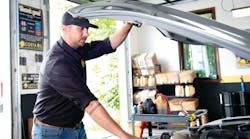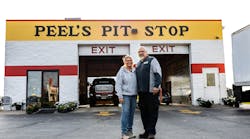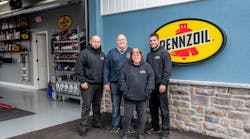The task: ensure the technicians who work at your shop are well-versed in the services they provide, and every detail that goes along with that. There are many nuances involved with this, as anyone who has trained someone knows. But the best way to check if your approach to quick lube training works is by putting it to the test. So, let’s take this assignment step by step.
First, you’ll meet The Teachers—two industry representatives who are informed on training techniques. Next, we’ll define The Students (And Their Tutors)—the people who are being trained and the people who should be training them, as well as how that pairing should be determined.
Then, you’ll learn The Study Guide—methods for laying the groundwork, how to build upon it, and how to detect if it’s working. Lastly, we’ll go over The Final Exam—the ultimate impact of training.
The Teachers
Meet two the two individuals who spoke with NOLN about what works (and what doesn’t) when it comes to training execution:
Kevin Davis
Founder of Quick Lube Expert (an online resource for quick lube owners and operators) and director of leadership and training for Oil Changers
Jared Rutberg
Chief operations officer, chief marketing officer, and president of Kwik Change Complete Automotive and Covington Pro Lube in Covington, Georgia
The Students (And Their Tutors)
A new hire could be completely fresh to the industry, or they could have years of experience. Regardless of their background, once they are on your team it’s important to get them on the same page as everyone else.
Kevin Davis says consistency is crucial. If you bring on someone who has worked in another shop and you don’t train them, they may bring in procedures that simply don’t work in your shop—and
this could lead to problems with the way services are rendered.
“I think the training program has to be the same program for every team member, regardless of their skill level or their experience, but you can let them kind of move through the trainings faster as they show their proficiency,” Davis says.
This means that some people may progress faster than others, but everyone should essentially start in the same place. Davis says a challenge he sees shops face with training is the lack of a systematic formal approach.
“The essence of any successful quick lube is going to be how effective and how well trained your team is, and your results are going to be a direct relation to your training,” Davis says.
You may be inclined to simply pair up a new hire with your best technician. This may work in some instances, but Davis says you lose consistency because that technician may train a shortcut or
miss some steps in procedure, and then that eventually gets passed along to others. Davis sees the manager as the point person for training.
“The manager should be the most educated, most informed, most current, most up-to-date person in
that location,” Davis says. “So, I think that the manager should be the main trainer. Now, when I say
that, does that mean that they do everything (and) they oversee everything? Absolutely not.”
He says the manager should know who has the best skills for a specific service or product, and they can assign training in those areas to the people who are a good fit. Then, the manager can observe and make sure processes are being followed.
Jared Rutberg says personality is a major consideration when matching a new hire with a trainer, because things may not work if people are not able to get through to each other. It needs to be a relationship that is conducive to progress.
“We find the best personality match because what it comes down to is we want the tech to learn
and be able to learn as quickly as possible,” Rutberg says. “And whatever is going to be the best fit
for them ... that’s what we’re going to go with.”
Rutberg says this means putting egos aside. If a match is made and it’s not working, team members
shouldn’t take it personally. In fact, he says the trainers are often the ones who bring up when
something’s not clicking.
“Usually, the trainer will go and raise the flag, ‘Hey, it doesn’t seem like I’m getting through to
this person, but I think this other person might be a better fit for them,’ and we’ll swap it out,” Rutberg
says.
The two-bay Covington Pro Lube shop sees 1,400 cars a month, so proper training is important to
efficiency. That means connecting the right people with each other to get the job done correctly with a communication style that works.
“A lot of that is just feel ... and see how they’re responding (and) how they’re reacting because each personality is different,” Rutberg says. “As I always tell all my managers, every brain’s a lock,
you just gotta find the key.”
The Study Guide
When you’re training for excellence, no detail can get missed. Rutberg’s new hires receive a training manual and a policy manual as required reading. In addition to hands-on in-house training, employees can participate in an in-house certification program custom tailored to the shops.
This involves the completion of two in-house exams: one is a 50-question price test in which the employee must score 90% to pass, and the other is a 50-question tech certification test in which the employee must score 92% to pass.
Once completed, they can get their certification, their certificate goes on a wall at the shop, and they get a pay raise. Ultimately, the employees decide if they want to pursue it. But the benefits
speak for themselves.
“As far as getting their certification goes, that’s up to the technician. We can’t go and force them ... there’s a point where ... we want you to have the certification, and you want the raise. You need to study and take your test,” Rutberg says.
There’s something for everyone, including training for customer service representatives and certification programs for not only technicians but also tires. The certification is a confidence boost.
Rutberg says they take a photo of the employee with their certification and post it on social media as a shout-out. Customers will even ask for their technician’s name and look to find them on the wall.
“The techs take great pride in getting their certificates up on the wall. I think they actually take more pride in that than they do the pay raise that comes with getting a certificate,” Rutberg says.
Tests can be offered in a written format or an oral format, depending upon what works best for the individual.
“All I care about is that you know the information,” Rutberg says. “I don’t care whether you know it by being able to write it down on a piece of paper or have to do it orally. That doesn’t matter. I just care that you know the information.”
To ensure retainment, Rutberg says technicians can be retested at any time and there are multiple versions of the test so the material can’t be memorized. If the technician fails a retest, they have 72 hours to pass it—so there is motivation to know your stuff.
When price changes are made (which Rutberg says they try to do all at once at the beginning of the calendar year), employees are given a week to review the changes and a new price test is issued.
Periodically, the team will have meetings about procedural changes and then have a page for the employees to fill out about the new information to make sure they understand it. Around once a year, they’ll do an after-hours training, order pizzas, and work through overarching changes or trends that are being seen at the shop.
Davis says setting groundwork starts before a new person is even hired.
“First of all, you need to have really good detailed written job descriptions for each position in your shop,” Davis says.
Clear expectations set the standard, and it doesn’t end there. He says having your standard operating procedures (SOPs) written out and detailed makes training smoother.
“Every service or product has a written standard operating procedure that is (a) guideline so they can assign that, but then you can measure that,” Davis says.
Davis finds the “tell, show, do” methodology to be helpful. This approach is a widely applied training tactic that is useful in a shop setting. The first step is setting those clear expectations, which extend from the initial job description to standard operating procedures to any visuals, videos, or things to read required from a trainee.
“After you explain it, you demonstrate that task yourself,” Davis says. “Whether it's you, the manager, or whether it's your lead tech, (or) your assistant manager, you allow them to shadow you, watching each step, highlighting the key components, making sure that they see everything.”
The next step is to let them do it.
“You have told them, you have shown them, now let’s give them some hands-on practice,” Davis says.
Davis gives an example of safely guiding a vehicle into a bay. Using “tell, show, do,” you can use an SOP to explain the “how” and “why” of correctly guiding a vehicle. Then, you show the trainee how to do it. Next, you have them demonstrate—and use a checklist with the specific training steps outlined for the task.
To ensure proficiency is reached, Davis says you should have them go through the training task multiple times, signing off on each checkbox to make sure all the right steps are taken. Communication is key—Davis says you want to make sure the trainee feels comfortable communicating with the trainer throughout the entire process.
“I always tell people, the only dumb question is the question that you don’t ask,” Davis says.
Davis stresses you should never set someone up to fail, and that “you never want to reprimand anybody in front of somebody. You always praise in public and reprimand in private.”
Consistently check in with the trainee to make sure things aren’t going too fast or too slowly. Davis advises correcting their course immediately when they’re about to make a mistake, because if things go uncorrected for too long, they won’t get better.
“All of the sudden, you’re building their trust, you’re building their confidence, and then whenever somebody's not comfortable with that, if you've got that transparency in that open communication policy, they can come to you and say, ‘I'm not really comfortable with this ... would you mind showing me again?’ So, I think you have to give that feedback continually,” Davis says.
The Final Exam
Knowledge gained from training sets the standard for how a shop operates. This can be exemplified in many ways.
For Rutberg, a well-trained team operates as a cohesive unit. His shops have standardized callouts. During the 17-point inspection, techs will call out their observations and the customer service rep will enter it into the ticket.
“So, everybody’s clear on it, we actually have a list of standardized terminology so that everybody’s speaking the same language,” Rutberg says.
Everyone understands one another, and the work is done fluidly. This environment fosters some of the customer service reps to even go on to become techs. It’s an example of continued education.
“So, they'll come out from behind the desk and become a tech. It's very easy for them to learn. They've already known everything that's in the shop ... they've learned all the call outs, they know what the prices are they've done all that stuff,” Rutberg says. “All they have to do is learn the hood.”
Effective training procedures don’t just make sure the job is getting done correctly—they inspire continued improvement.
“Training is a never-ending process,” Davis says.
He says training begins with getting people comfortable with the company, then getting them comfortable with products and services in the first 30 to 90 days, and then you can start developing them as an employee with a willingness to move someone to what he calls the “next level” when necessary. Davis says this is part of how you “build that bench” of team support.
Davis says with the right training, there is great potential for employee reviews to go up while bay times, warranties, and claims go down. Additionally, revenue and add-on services can go up—and he says it’s all directly linked to that training program.
“So, when you have a good training program, you're encouraging that culture of continuous learning,” Davis says. “You encourage them to foster innovation and you're getting them to be creative and (have) problem-solving skills.”





